Advancing CO2 Solubility Prediction in Brine Solutions with Explainable Artificial Intelligence for Sustainable Subsurface Storage
Abstract
1. Introduction
2. Materials and Methods
2.1. Materials
Database
2.2. Methods
2.2.1. Random Forest
2.2.2. Shapley Additive exPlanations
2.2.3. Friedman H-Statistics
3. Results and Discussion
3.1. Data Preparation
3.1.1. Duplicates Removal
3.1.2. Feature Extraction
3.1.3. Feature Engineering
3.1.4. Data Split
3.1.5. Data Characteristics
3.2. Modelling
3.2.1. Model Development
3.2.2. Model Stability
3.2.3. Model Explaining
3.3. Discussion
4. Practical Implications
5. Summary and Conclusions
Author Contributions
Funding
Institutional Review Board Statement
Informed Consent Statement
Data Availability Statement
Conflicts of Interest
Nomenclature
| Parameters | |
| AARD | Average Absolute Relative Deviation |
| Ca2+ | Calcium ion |
| Cl− | Chloride ion |
| EoS | Equations of State |
| H-statistics | Friedman H-statistics |
| IS | Ionic Strength |
| K+ | Potassium ion |
| max | Maximum value |
| min | Minimum value |
| Mg2+ | Magnesium ion |
| MW | Molecular Weight, g/mol |
| Na+ | Sodium ion |
| NO3− | Nitrate ion |
| P | Pressure, MPa |
| Q1 | First quartile |
| Q3 | Third quartile |
| R2 | Coefficient of Determination |
| RMSE | Root Mean Squared Error |
| SO42− | Sulphate ion |
| std | Standard deviation |
| T | Temperature, K |
| t | Target value |
| x | CO2 solubility, mole fraction |
| y | Model output |
| Abbreviations | |
| ANFIS | Adaptive Neuro-Fuzzy Inference System |
| ANN | Artificial Neural Network |
| CaCl2 | Calcium Chloride |
| CCS | Carbon Capture and Storage |
| CO2 | Carbon Dioxide |
| COA | Cuckoo Optimization Algorithm |
| DT | Decision Tree |
| ELM | Extreme Learning Machine |
| GA | Genetic Algorithm |
| GEP | Gene Expression Programming |
| GHG | Greenhouse Gas |
| KCl | Potassium Chloride |
| KNN | K-nearest Neighbour |
| KNO3 | Potassium Nitrate |
| LSSVM | Least Squares Support Vector Machine |
| MgCl2 | Magnesium Chloride |
| MgSO4 | Magnesium Sulphate |
| MLP | Multilayer Perceptron |
| Na2SO4 | Sodium Sulphate |
| NaCl | Sodium Chloride |
| NaHCO3 | Sodium bicarbonate |
| NaNO3 | Sodium Nitrate |
| NaOH | Sodium Hydroxide |
| NaBr | Sodium Bromide |
| RBFNN | Radial Basis Function Neural Network |
| RF | Random Forest |
| SHAP | SHapley Additive exPlanations |
| SVR | Support Vector Regression |
| XAI | Explainable Artificial Intelligence |
| XGB | Extreme Gradient Boosting |
Appendix A
References
- Scott, V.; Gilfillan, S.; Markusson, N.; Chalmers, H.; Haszeldine, R.S. Last chance for carbon capture and storage. Nat. Clim. Chang. 2013, 3, 105–111. [Google Scholar] [CrossRef]
- Boot-Handford, M.E.; Abanades, J.C.; Anthony, E.J.; Blunt, M.J.; Brandani, S.; Mac Dowell, N.; Fernández, J.R.; Ferrari, M.C.; Gross, R.; Hallett, J.P.; et al. Carbon capture and storage update. Energy Environ. Sci. 2014, 7, 130–189. [Google Scholar] [CrossRef]
- Tan, Y.; Nookuea, W.; Li, H.; Thorin, E.; Yan, J. Property impacts on Carbon Capture and Storage (CCS) processes: A review. Energy Convers. Manag. 2016, 118, 204–222. [Google Scholar] [CrossRef]
- Bui, M.; Adjiman, C.S.; Bardow, A.; Anthony, E.J.; Boston, A.; Brown, S.; Fennell, P.S.; Fuss, S.; Galindo, A.; Hackett, L.A.; et al. Carbon capture and storage (CCS): The way forward. Energy Environ. Sci. 2018, 11, 1062–1176. [Google Scholar] [CrossRef]
- Shen, M.; Kong, F.; Tong, L.; Luo, Y.; Yin, S.; Liu, C.; Zhang, P.; Wang, L.; Chu, P.K.; Ding, Y. Carbon capture and storage (CCS): Development path based on carbon neutrality and economic policy. Carbon Neutrality 2022, 1, 37. [Google Scholar] [CrossRef]
- Bachu, S. CO2 storage in geological media: Role, means, status and barriers to deployment. Prog. Energy Combust. Sci. 2008, 34, 254–273. [Google Scholar] [CrossRef]
- Gaspar Ravagnani, A.T.F.S.; Ligero, E.L.; Suslick, S.B. CO2 sequestration through enhanced oil recovery in a mature oil field. J. Pet. Sci. Eng. 2009, 65, 129–138. [Google Scholar] [CrossRef]
- Hamza, A.; Hussein, I.A.; Al-Marri, M.J.; Mahmoud, M.; Shawabkeh, R.; Aparicio, S. CO2 enhanced gas recovery and sequestration in depleted gas reservoirs: A review. J. Pet. Sci. Eng. 2021, 196, 107685. [Google Scholar] [CrossRef]
- Iloejesi, C.O.; Beattie, W.; O’Donnell, F.C.; Beckingham, L.E. Accelerating CO2 Storage Site Characterization through a New Understanding of Favorable Formation Properties and the Impact of Core-Scale Heterogeneities. Sustainability 2024, 16, 5515. [Google Scholar] [CrossRef]
- Qi, R.; LaForce, T.C.; Blunt, M.J. Design of carbon dioxide storage in aquifers. Int. J. Greenh. Gas Control. 2009, 3, 195–205. [Google Scholar] [CrossRef]
- Kaplan, R.; Mamrosh, D.; Salih, H.H.; Dastgheib, S.A. Assessment of desalination technologies for treatment of a highly saline brine from a potential CO2 storage site. Desalination 2017, 404, 87–101. [Google Scholar] [CrossRef]
- Fominykh, S.; Stankovski, S.; Markovic, V.M.; Petrovic, D.; Osmanović, S. Analysis of CO2 Migration in Horizontal Saline Aquifers during Carbon Capture and Storage Process. Sustainability 2023, 15, 8912. [Google Scholar] [CrossRef]
- Ghanbari, S.; Al-Zaabi, Y.; Pickup, G.E.; Mackay, E.; Gozalpour, F.; Todd, A.C. Simulation of CO2 Storage in Saline Aquifers. Chem. Eng. Res. Des. 2006, 84, 764–775. [Google Scholar] [CrossRef]
- Chen, H.; Yu, H.; Zhou, B.; Wang, R.; Dai, Q.; Qi, X.; Aliyu Lawan, L.; Abro, Z. Storage Mechanism and Dynamic Characteristics of CO2 Dissolution in Saline Aquifers. Energy Fuels 2023, 37, 3875–3885. [Google Scholar] [CrossRef]
- Pau, G.S.; Bell, J.B.; Pruess, K.; Almgren, A.S.; Lijewski, M.J.; Zhang, K. High-resolution simulation and characterization of density-driven flow in CO2 storage in saline aquifers. Adv. Water Resour. 2010, 33, 443–455. [Google Scholar] [CrossRef]
- Class, H.; Bürkle, P.; Sauerborn, T.; Trötschler, O.; Strauch, B.; Zimmer, M. On the Role of Density-Driven Dissolution of CO2 in Phreatic Karst Systems. Water Resour. Res. 2021, 57, e2021WR030912. [Google Scholar] [CrossRef]
- Kaszuba, J.; Yardley, B.; Andreani, M. Experimental Perspectives of Mineral Dissolution and Precipitation due to Carbon Dioxide-Water-Rock Interactions. Rev. Mineral. Geochem. 2013, 77, 153–188. [Google Scholar] [CrossRef]
- Fatah, A.; Ben Mahmud, H.; Bennour, Z.; Gholami, R.; Hossain, M. Geochemical modelling of CO2 interactions with shale: Kinetics of mineral dissolution and precipitation on geological time scales. Chem. Geol. 2022, 592, 120742. [Google Scholar] [CrossRef]
- Edem, D.E.; Abba, M.K.; Nourian, A.; Babaie, M.; Naeem, Z. Experimental Study on the Interplay between Different Brine Types/Concentrations and CO2 Injectivity for Effective CO2 Storage in Deep Saline Aquifers. Sustainability 2022, 14, 986. [Google Scholar] [CrossRef]
- Suekane, T.; Nobuso, T.; Hirai, S.; Kiyota, M. Geological storage of carbon dioxide by residual gas and solubility trapping. Int. J. Greenh. Gas Control. 2008, 2, 58–64. [Google Scholar] [CrossRef]
- Al Hameli, F.; Belhaj, H.; Al Dhuhoori, M. CO2 Sequestration Overview in Geological Formations: Trapping Mechanisms Matrix Assessment. Energies 2022, 15, 7805. [Google Scholar] [CrossRef]
- Sander, W. Über die Löslichkeit der Kohlensäure in Wasser und einigen andern Lösungsmitteln unter höhern Drucken. Z. Für Phys. Chem. 1911, 78, 513–549. [Google Scholar] [CrossRef]
- Wiebe, R.; Gaddy, V.L. The solubility in water of carbon dioxide at 50, 75 and 100°, at pressures to 700 atmospheres. J. Am. Chem. Soc. 1939, 61, 315–318. [Google Scholar] [CrossRef]
- Wiebe, R.; Gaddy, V. The solubility of carbon dioxide in water at various temperatures from 12 to 40 and at pressures to 500 atmospheres. Critical phenomena. J. Am. Chem. Soc. 1940, 62, 815–817. [Google Scholar] [CrossRef]
- Tödheide, K.; Franck, E.U. Das zweiphasengebiet und die kritische kurve im system kohlendioxid–wasser bis zu drucken von 3500 bar. Z. Fur Phys. Chem. 1963, 37, 387–401. [Google Scholar] [CrossRef]
- Takenouchi, S.; Kennedy, G.C. The binary system H2O-CO2 at high temperatures and pressures. Am. J. Sci. 1964, 262, 1055–1074. [Google Scholar] [CrossRef]
- Liu, B.; Mahmood, B.S.; Mohammadian, E.; Khaksar Manshad, A.; Rosli, N.R.; Ostadhassan, M. Measurement of Solubility of CO2 in NaCl, CaCl2, MgCl2 and MgCl2 + CaCl2 Brines at Temperatures from 298 to 373 K and Pressures up to 20 MPa Using the Potentiometric Titration Method. Energies 2021, 14, 7222. [Google Scholar] [CrossRef]
- Chabab, S.; Ahmadi, P.; Théveneau, P.; Coquelet, C.; Chapoy, A.; Corvisier, J.; Paricaud, P. Measurements and Modeling of High-Pressure O2 and CO2 Solubility in Brine (H2O + NaCl) between 303 and 373 K and Pressures up to 36 MPa. J. Chem. Eng. Data 2021, 66, 609–620. [Google Scholar] [CrossRef]
- dos Santos, P.F.; André, L.; Ducousso, M.; Contamine, F.; Cézac, P. Experimental Measurement of CO2 Solubility in Aqueous Na2SO4 Solution at Temperatures between 303.15 and 423.15 K and Pressures up to 20 MPa. J. Chem. Eng. Data 2020, 65, 3230–3239. [Google Scholar] [CrossRef]
- Steel, L.; Liu, Q.; Mackay, E.; Maroto-Valer, M.M. CO2 solubility measurements in brine under reservoir conditions: A comparison of experimental and geochemical modeling methods. Greenh. Gases Sci. Technol. 2016, 6, 197–217. [Google Scholar] [CrossRef]
- Bamberger, A.; Sieder, G.; Maurer, G. High-pressure (vapor + liquid) equilibrium in binary mixtures of (carbon dioxide+water or acetic acid) at temperatures from 313 to 353 K. J. Supercrit. Fluids 2000, 17, 97–110. [Google Scholar] [CrossRef]
- Servio, P.; Englezos, P. Effect of temperature and pressure on the solubility of carbon dioxide in water in the presence of gas hydrate. Fluid Phase Equilibria 2001, 190, 127–134. [Google Scholar] [CrossRef]
- Kiepe, J.; Horstmann, S.; Fischer, K.; Gmehling, J. Experimental Determination and Prediction of Gas Solubility Data for CO2 + H2O Mixtures Containing NaCl or KCl at Temperatures between 313 and 393 K and Pressures up to 10 MPa. Ind. Eng. Chem. Res. 2002, 41, 4393–4398. [Google Scholar] [CrossRef]
- Teng, H.; Yamasaki, A. Pressure-mole fraction phase diagrams for co 2-pure water system under temperatures and pressures corresponding to ocean waters at depth to 3000 M. Chem. Eng. Commun. 2002, 189, 1485–1497. [Google Scholar] [CrossRef]
- Li, Z.; Dong, M.; Li, S.; Dai, L. Densities and Solubilities for Binary Systems of Carbon Dioxide + Water and Carbon Dioxide + Brine at 59 °C and Pressures to 29 MPa. J. Chem. Eng. Data 2004, 49, 1026–1031. [Google Scholar] [CrossRef]
- Ferrentino, G.; Barletta, D.; Donsì, F.; Poletto, M. Experimental Measurements and Thermodynamic Modeling of CO2 Solubility at High Pressure in Model Apple Juices. Ind. Eng. Chem. Res. 2010, 49, 2992–3000. [Google Scholar] [CrossRef]
- Liu, Y.; Hou, M.; Yang, G.; Han, B. Solubility of CO2 in aqueous solutions of NaCl, KCl, CaCl2 and their mixed salts at different temperatures and pressures. J. Supercrit. Fluids 2011, 56, 125–129. [Google Scholar] [CrossRef]
- Li, Y.-K.; Nghiem, L.X. Phase equilibria of oil, gas and water/brine mixtures from a cubic equation of state and henry’s law. Can. J. Chem. Eng. 1986, 64, 486–496. [Google Scholar]
- Sørensen, H.; Pedersen, K.S.; Christensen, P.L. Modeling of gas solubility in brine. Org. Geochem. 2002, 33, 635–642. [Google Scholar] [CrossRef]
- Duan, Z.; Sun, R. An improved model calculating CO2 solubility in pure water and aqueous NaCl solutions from 273 to 533 K and from 0 to 2000 bar. Chem. Geol. 2003, 193, 257–271. [Google Scholar] [CrossRef]
- Portier, S.; Rochelle, C. Modelling CO2 solubility in pure water and NaCl-type waters from 0 to 300 °C and from 1 to 300 bar: Application to the Utsira Formation at Sleipner. Chem. Geol. 2005, 217, 187–199. [Google Scholar] [CrossRef]
- Yan, W.; Huang, S.; Stenby, E.H. Measurement and modeling of CO2 solubility in NaCl brine and CO2–saturated NaCl brine density. Int. J. Greenh. Gas Control. 2011, 5, 1460–1477. [Google Scholar] [CrossRef]
- Ziabakhsh-Ganji, Z.; Kooi, H. An Equation of State for thermodynamic equilibrium of gas mixtures and brines to allow simulation of the effects of impurities in subsurface CO2 storage. Int. J. Greenh. Gas Control. 2012, 11, S21–S34. [Google Scholar] [CrossRef]
- Duan, Z.; Sun, R. A model to predict phase equilibrium of CH4 and CO2 clathrate hydrate in aqueous electrolyte solutions. Am. Miner. 2006, 91, 1346–1354. [Google Scholar] [CrossRef]
- Mao, S.; Zhang, D.; Li, Y.; Liu, N. An improved model for calculating CO2 solubility in aqueous NaCl solutions and the application to CO2–H2O–NaCl fluid inclusions. Chem. Geol. 2013, 347, 43–58. [Google Scholar] [CrossRef]
- Spycher, N.; Pruess, K. CO2-H2O mixtures in the geological sequestration of CO2. II. Partitioning in chloride brines at 12–100 °C and up to 600 bar. Geochim. Cosmochim. Acta 2005, 69, 3309–3320. [Google Scholar] [CrossRef]
- Bahadori, A.; Vuthaluru, H.B.; Mokhatab, S. New correlations predict aqueous solubility and density of carbon dioxide. Int. J. Greenh. Gas Control. 2009, 3, 474–480. [Google Scholar] [CrossRef]
- Spycher, N.; Pruess, K. A Phase-Partitioning Model for CO2–Brine Mixtures at Elevated Temperatures and Pressures: Application to CO2-Enhanced Geothermal Systems. Transp. Porous Media 2010, 82, 173–196. [Google Scholar] [CrossRef]
- Mao, S.; Hu, J.; Zhang, Y.; Lü, M. A predictive model for the PVTx properties of CO2–H2O–NaCl fluid mixture up to high temperature and high pressure. Appl. Geochem. 2015, 54, 54–64. [Google Scholar] [CrossRef]
- Hemmati-Sarapardeh, A.; Amar, M.N.; Soltanian, M.R.; Dai, Z.; Zhang, X. Modeling CO2 Solubility in Water at High Pressure and Temperature Conditions. Energy Fuels 2020, 34, 4761–4776. [Google Scholar] [CrossRef]
- Wilhelmsen, Ø.; Aasen, A.; Skaugen, G.; Aursand, P.; Austegard, A.; Aursand, E.; Gjennestad, M.A.; Lund, H.; Linga, G.; Hammer, M. Thermodynamic Modeling with Equations of State: Present Challenges with Established Methods. Ind. Eng. Chem. Res. 2017, 56, 3503–3515. [Google Scholar] [CrossRef]
- von Solms, N.; Kouskoumvekaki, I.A.; Michelsen, M.L.; Kontogeorgis, G.M. Capabilities, limitations and challenges of a simplified PC-SAFT equation of state. Fluid Phase Equilibria 2006, 241, 344–353. [Google Scholar] [CrossRef]
- Span, R.; Wagner, W.; Lemmon, E.; Jacobsen, R. Multiparameter equations of state—Recent trends and future challenges. Fluid Phase Equilibria 2001, 183–184, 1–20. [Google Scholar] [CrossRef]
- Nouri-Taleghani, M.; Mahmoudifar, M.; Shokrollahi, A.; Tatar, A.; Karimi-Khaledi, M. Fracture density determination using a novel hybrid computational scheme: A case study on an Iranian Marun oil field reservoir. J. Geophys. Eng. 2015, 12, 188–198. [Google Scholar] [CrossRef]
- Tatar, A.; Shokrollahi, A.; Halali, M.A.; Azari, V.; Safari, H. A Hybrid Intelligent Computational Scheme for Determination of Refractive Index of Crude Oil Using SARA Fraction Analysis. Can. J. Chem. Eng. 2015, 93, 1547–1555. [Google Scholar] [CrossRef]
- Li, W.; Nan, Y.; You, Q.; Jin, Z. CO2 solubility in brine in silica nanopores in relation to geological CO2 sequestration in tight formations: Effect of salinity and pH. Chem. Eng. J. 2021, 411, 127626. [Google Scholar] [CrossRef]
- Ratnakar, R.R.; Venkatraman, A.; Kalra, A.; Dindoruk, B. On the prediction of gas solubility in brine solutions with single or mixed salts: Applications to gas injection and CO2 capture/sequestration. J. Nat. Gas Sci. Eng. 2020, 81, 103450. [Google Scholar] [CrossRef]
- Khan, M.N.A.; Haq, Z.U.; Ullah, H.; Naqvi, S.R.; Ahmed, U.; Zaman, M.; Amin, N.A.S. Prediction of hydrogen yield from supercritical gasification process of sewage sludge using machine learning and particle swarm hybrid strategy. Int. J. Hydrogen Energy 2024, 54, 512–525. [Google Scholar] [CrossRef]
- AlNazr, H.A.; Ahmad, N.; Ahmed, U.; Mohan, B.; Jameel, A.G.A. Predicting physical properties of oxygenated gasoline and diesel range fuels using machine learning. Alex. Eng. J. 2023, 76, 193–219. [Google Scholar] [CrossRef]
- Ratnakar, R.R.; Chaubey, V.; Dindoruk, B. A novel computational strategy to estimate CO2 solubility in brine solutions for CCUS applications. Appl. Energy 2023, 342, 121134. [Google Scholar] [CrossRef]
- Sun, B.; He, H.; Sun, X.; Li, X.; Wang, Z. Prediction method of solubility of carbon dioxide and methane during gas invasion in deep-water drilling. J. Contam. Hydrol. 2022, 251, 104081. [Google Scholar] [CrossRef]
- Mohammadian, E.; Liu, B.; Riazi, A.; Banerjee, S.; Goncalves, P.; Sen, K. Evaluation of Different Machine Learning Frameworks to Estimate CO2 Solubility in NaCl Brines: Implications for CO2 Injection into Low-Salinity Formations. Lithosphere 2022, 2022, 1615832. [Google Scholar] [CrossRef]
- Jeon, P.R.; Lee, C.-H. Artificial neural network modelling for solubility of carbon dioxide in various aqueous solutions from pure water to brine. J. CO2 Util. 2021, 47, 101500. [Google Scholar] [CrossRef]
- Sayahi, T.; Tatar, A.; Rostami, A.; Anbaz, M.A.; Shahbazi, K. Determining solubility of CO2 in aqueous brine systems via hybrid smart strategies. Int. J. Comput. Appl. Technol. 2021, 65, 1–13. [Google Scholar] [CrossRef]
- Nabipour, N.; Qasem, S.N.; Salwana, E.; Baghban, A. Evolving LSSVM and ELM models to predict solubility of non-hydrocarbon gases in aqueous electrolyte systems. Measurement 2020, 164, 107999. [Google Scholar] [CrossRef]
- Raji, M.; Dashti, A.; Amani, P.; Mohammadi, A.H. Efficient estimation of CO2 solubility in aqueous salt solutions. J. Mol. Liq. 2019, 283, 804–815. [Google Scholar] [CrossRef]
- Menad, N.A.; Hemmati-Sarapardeh, A.; Varamesh, A.; Shamshirband, S. Predicting solubility of CO2 in brine by advanced machine learning systems: Application to carbon capture and sequestration. J. CO2 Util. 2019, 33, 83–95. [Google Scholar] [CrossRef]
- Ali Ahmadi, M.; Ahmadi, A. Applying a sophisticated approach to predict CO2 solubility in brines: Application to CO2 sequestration. Int. J. Low-Carbon Technol. 2016, 11, 325–332. [Google Scholar] [CrossRef]
- Prutton, C.F.; Savage, R.L. The Solubility of Carbon Dioxide in Calcium Chloride-Water Solutions at 75, 100, 120° and High Pressures1. J. Am. Chem. Soc. 1945, 67, 1550–1554. [Google Scholar] [CrossRef]
- Nighswander, J.A.; Kalogerakis, N.; Mehrotra, A.K. Solubilities of carbon dioxide in water and 1 wt. % sodium chloride solution at pressures up to 10 MPa and temperatures from 80 to 200.degree.C. J. Chem. Eng. Data 1989, 34, 355–360. [Google Scholar] [CrossRef]
- Zheng, D.-Q.; Guo, T.-M.; Knapp, H. Experimental and modeling studies on the solubility of CO2, CHC1F2, CHF3, C2H2F4 and C2H4F2 in water and aqueous NaCl solutions under low pressures. Fluid Phase Equilibria 1997, 129, 197–209. [Google Scholar] [CrossRef]
- Bando, S.; Takemura, F.; Nishio, M.; Hihara, E.; Akai, M. Solubility of CO2 in Aqueous Solutions of NaCl at (30 to 60) °C and (10 to 20) MPa. J. Chem. Eng. Data 2003, 48, 576–579. [Google Scholar] [CrossRef]
- Rosenqvist, J.; Kilpatrick, A.D.; Yardley, B.W. Solubility of carbon dioxide in aqueous fluids and mineral suspensions at 294 K and subcritical pressures. Appl. Geochem. 2012, 27, 1610–1614. [Google Scholar] [CrossRef]
- Savary, V.; Berger, G.; Dubois, M.; Lacharpagne, J.-C.; Pages, A.; Thibeau, S.; Lescanne, M. The solubility of CO2 + H2S mixtures in water and 2M NaCl at 120 °C and pressures up to 35MPa. Int. J. Greenh. Gas Control. 2012, 10, 123–133. [Google Scholar] [CrossRef]
- Bastami, A.; Allahgholi, M.; Pourafshary, P. Experimental and modelling study of the solubility of CO2 in various CaCl2 solutions at different temperatures and pressures. Pet. Sci. 2014, 11, 569–577. [Google Scholar] [CrossRef]
- Guo, H.; Chen, Y.; Hu, Q.; Lu, W.; Ou, W.; Geng, L. Quantitative Raman spectroscopic investigation of geo-fluids high-pressure phase equilibria: Part I. Accurate calibration and determination of CO2 solubility in water from 273.15 to 573.15 K and from 10 to 120 MPa. Fluid Phase Equilibria 2014, 382, 70–79. [Google Scholar] [CrossRef]
- Carvalho, P.J.; Pereira, L.M.; Gonçalves, N.P.; Queimada, A.J.; Coutinho, J.A. Carbon dioxide solubility in aqueous solutions of NaCl: Measurements and modeling with electrolyte equations of state. Fluid Phase Equilibria 2015, 388, 100–106. [Google Scholar] [CrossRef]
- Mohammadian, E.; Hamidi, H.; Asadullah, M.; Azdarpour, A.; Motamedi, S.; Junin, R. Measurement of CO2 Solubility in NaCl Brine Solutions at Different Temperatures and Pressures Using the Potentiometric Titration Method. J. Chem. Eng. Data 2015, 60, 2042–2049. [Google Scholar] [CrossRef]
- Zhao, H.; Fedkin, M.V.; Dilmore, R.M.; Lvov, S.N. Carbon dioxide solubility in aqueous solutions of sodium chloride at geological conditions: Experimental results at 323.15, 373.15, and 423.15 K and 150 bar and modeling up to 573.15 K and 2000 bar. Geochim. Cosmochim. Acta 2015, 149, 165–189. [Google Scholar] [CrossRef]
- Jacob, R.; Saylor, B.Z. CO2 solubility in multi-component brines containing NaCl, KCl, CaCl2 and MgCl2 at 297 K and 1–14 MPa. Chem. Geol. 2016, 424, 86–95. [Google Scholar] [CrossRef]
- Messabeb, H.; Contamine, F.; Cézac, P.; Serin, J.P.; Gaucher, E.C. Experimental Measurement of CO2 Solubility in Aqueous NaCl Solution at Temperature from 323.15 to 423.15 K and Pressure of up to 20 MPa. J. Chem. Eng. Data 2016, 61, 3573–3584. [Google Scholar] [CrossRef]
- Mousavi Belfeh Teymouri, S.R. Phase Equilibria Measurements and Modelling of CO2–Rich Fluids/Brine Systems. Ph.D. Thesis, Heriot-Watt University, Edinburgh, UK, 2016. [Google Scholar]
- Truche, L.; Bazarkina, E.F.; Berger, G.; Caumon, M.-C.; Bessaque, G.; Dubessy, J. Direct measurement of CO2 solubility and pH in NaCl hydrothermal solutions by combining in-situ potentiometry and Raman spectroscopy up to 280 °C and 150 bar. Geochim. Cosmochim. Acta 2016, 177, 238–253. [Google Scholar] [CrossRef]
- Deng, K.; Lin, Y.; Ning, H.; Liu, W.; Singh, A.; Zhang, G. Influences of temperature and pressure on CO2 solubility in saline solutions in simulated oil and gas well environments. Appl. Geochem. 2018, 99, 22–30. [Google Scholar] [CrossRef]
- Wang, J.; He, B.; Xie, L.; Bei, K.; Li, G.; Chen, Z.; Chou, I.-M.; Lin, C.; Pan, Z. Determination of CO2 Solubility in Water and NaCl Solutions under Geological Sequestration Conditions Using a Fused Silica Capillary Cell with in Situ Raman Spectroscopy. J. Chem. Eng. Data 2019, 64, 2484–2496. [Google Scholar] [CrossRef]
- Lara Cruz, J.; Neyrolles, E.; Contamine, F.; Cézac, P. Experimental Study of Carbon Dioxide Solubility in Sodium Chloride and Calcium Chloride Brines at 333.15 and 453.15 K for Pressures up to 40 MPa. J. Chem. Eng. Data 2021, 66, 249–261. [Google Scholar] [CrossRef]
- Tong, D.; Trusler, J.P.M.; Vega-Maza, D. Solubility of CO2 in Aqueous Solutions of CaCl2 or MgCl2 and in a Synthetic Formation Brine at Temperatures up to 423 K and Pressures up to 40 MPa. J. Chem. Eng. Data 2013, 58, 2116–2124. [Google Scholar] [CrossRef]
- Zhao, H.; Dilmore, R.M.; Lvov, S.N. Experimental studies and modeling of CO2 solubility in high temperature aqueous CaCl2, MgCl2, Na2SO4, and KCl solutions. AIChE J. 2015, 61, 2286–2297. [Google Scholar] [CrossRef]
- Messabeb, H.; Contamine, F.; Cézac, P.; Serin, J.P.; Pouget, C.; Gaucher, E.C. Experimental Measurement of CO2 Solubility in Aqueous CaCl2 Solution at Temperature from 323.15 to 423.15 K and Pressure up to 20 MPa Using the Conductometric Titration. J. Chem. Eng. Data 2017, 62, 4228–4234. [Google Scholar] [CrossRef]
- Poulain, M.; Poulain, M.; Messabeb, H.; Contamine, F.; Cézac, P.; Serin, J.P.; Dupin, J.C.; Martinez, H. Experimental Measurement of CO2 Solubility in a 1 mol/kgw CaCl2 Solution at Temperature from 323.15 to 423.15 K and Pressure up to 20 MPa. In Cutting-Edge Technology for Carbon Capture, Utilization, and Storage; John Wiley & Sons: Hoboken, NJ, USA, 2018; pp. 123–134. [Google Scholar]
- Hou, S.-X.; Maitland, G.C.; Trusler, J.P.M. Phase equilibria of (CO2 + H2O + NaCl) and (CO2 + H2O + KCl): Measurements and modeling. J. Supercrit. Fluids 2013, 78, 78–88. [Google Scholar] [CrossRef]
- Kiepe, J.; Horstmann, S.; Fischer, K.; Gmehling, J. Experimental Determination and Prediction of Gas Solubility Data for CO2 + H2O Mixtures Containing NaNO3 or KNO3. Ind. Eng. Chem. Res. 2003, 42, 3851–3856. [Google Scholar] [CrossRef]
- Rumpf, B.; Nicolaisen, H.; Öcal, C.; Maurer, G. Solubility of carbon dioxide in aqueous solutions of sodium chloride: Experimental results and correlation. J. Solut. Chem. 1994, 23, 431–448. [Google Scholar] [CrossRef]
- Guo, H.; Huang, Y.; Chen, Y.; Zhou, Q. Quantitative Raman Spectroscopic Measurements of CO2 Solubility in NaCl Solution from (273.15 to 473.15) K at p = (10.0, 20.0, 30.0, and 40.0) MPa. J. Chem. Eng. Data 2016, 61, 466–474. [Google Scholar] [CrossRef]
- Chabab, S.; Théveneau, P.; Corvisier, J.; Coquelet, C.; Paricaud, P.; Houriez, C.; Ahmar, E.E. Thermodynamic study of the CO2–H2O–NaCl system: Measurements of CO2 solubility and modeling of phase equilibria using Soreide and Whitson, electrolyte CPA and SIT models. Int. J. Greenh. Gas Control. 2019, 91, 102825. [Google Scholar] [CrossRef]
- Poulain, M.; Messabeb, H.; Lach, A.; Contamine, F.; Cézac, P.; Serin, J.-P.; Dupin, J.-C.; Martinez, H. Experimental Measurements of Carbon Dioxide Solubility in Na–Ca–K–Cl Solutions at High Temperatures and Pressures up to 20 MPa. J. Chem. Eng. Data 2019, 64, 2497–2503. [Google Scholar] [CrossRef]
- El-Maghraby, R.M.; Pentland, C.H.; Iglauer, S.; Blunt, M.J. A fast method to equilibrate carbon dioxide with brine at high pressure and elevated temperature including solubility measurements. J. Supercrit. Fluids 2012, 62, 55–59. [Google Scholar] [CrossRef]
- Breiman, L. Random Forests. Mach. Learn. 2001, 45, 5–32. [Google Scholar] [CrossRef]
- Hart, S. Shapley Value. In Game Theory; Eatwell, J., Milgate, M., Newman, P., Eds.; Palgrave Macmillan: London, UK, 1989; pp. 210–216. [Google Scholar]
- Rodríguez-Pérez, R.; Bajorath, J. Interpretation of machine learning models using shapley values: Application to compound potency and multi-target activity predictions. J. Comput. Mol. Des. 2020, 34, 1013–1026. [Google Scholar] [CrossRef]
- Friedman, J.H.; Popescu, B.E. Predictive learning via rule ensembles. Ann. Appl. Stat. 2008, 2, 916–954. [Google Scholar] [CrossRef]
- Inglis, A.; Parnell, A.; Hurley, C.B. Visualizing Variable Importance and Variable Interaction Effects in Machine Learning Models. J. Comput. Graph. Stat. 2022, 31, 766–778. [Google Scholar] [CrossRef]
- Hosseini, M.; Leonenko, Y. Development of explicit models to predict methane hydrate equilibrium conditions in pure water and brine solutions: A machine learning approach. Chem. Eng. Sci. 2024, 286, 119603. [Google Scholar] [CrossRef]
- Danesh, A. PVT and Phase Behaviour of Petroleum Reservoir Fluids; Elsevier: Amsterdam, The Netherlands, 1998. [Google Scholar]
- Abdi, J.; Bastani, D.; Abdi, J.; Mahmoodi, N.M.; Shokrollahi, A.; Mohammadi, A.H. Assessment of competitive dye removal using a reliable method. J. Environ. Chem. Eng. 2014, 2, 1672–1683. [Google Scholar] [CrossRef]
- Foroughizadeh, P.; Shokrollahi, A.; Tatar, A.; Zeinijahromi, A. Hydrogen solubility in different chemicals: A modelling approach and review of literature data. Eng. Appl. Artif. Intell. 2024, 136, 108978. [Google Scholar] [CrossRef]
- Lundberg, S.M.; Lee, S.-I. A unified approach to interpreting model predictions. In Proceedings of the 31st International Conference on Neural Information Processing Systems, Long Beach, CA, USA, 4–9 December 2017; Volume 30. [Google Scholar]
- Rossum, V. Python Tutorial, Technical Report CS-R9526; CWI: Amsterdam, The Netherlands, 1995. [Google Scholar]
- Harris, C.R.; Millman, K.J.; van der Walt, S.J.; Gommers, R.; Virtanen, P.; Cournapeau, D.; Wieser, E.; Taylor, J.; Berg, S.; Smith, N.J.; et al. Array programming with NumPy. Nature 2020, 585, 357–362. [Google Scholar] [CrossRef] [PubMed]
- McKinney, W. Data structures for statistical computing in python. In Proceedings of the 9th Python in Science Conference, Austin, TX, USA, 28 June–3 July 2010; pp. 51–56. [Google Scholar]
- Hunter, J.D. Matplotlib: A 2D graphics environment. Comput. Sci. Eng. 2007, 9, 90–95. [Google Scholar] [CrossRef]
- Waskom, M.; Botvinnik, O.; O’Kane, D.; Hobson, P.; Lukauskas, S.; Gemperline, D.C.; Augspurger, T.; Halchenko, Y.; Cole, J.B.; Warmenhoven, J. Mwaskom/Seaborn: V0. 8.1 (September 2017); Zenodo: Genève, Switzerland, 2017. [Google Scholar]
- Pedregosa, F.; Varoquaux, G.; Gramfort, A.; Michel, V.; Thirion, B.; Grisel, O.; Blondel, M.; Prettenhofer, P.; Weiss, R.; Dubourg, V. Scikit-learn: Machine learning in Python. J. Mach. Learn. Res. 2011, 12, 2825–2830. [Google Scholar]
- Virtanen, P.; Gommers, R.; Oliphant, T.E.; Haberland, M.; Reddy, T.; Cournapeau, D.; Burovski, E.; Peterson, P.; Weckesser, W.; Bright, J. SciPy 1.0: Fundamental algorithms for scientific computing in Python. Nat. Methods 2020, 17, 261–272. [Google Scholar] [CrossRef]
- Zolkowski, A.; Krzyziński, M.; Fijałkowski, P.M. Methods for Extraction of Interactions from Predictive Models. Ph.D. Thesis, Warsaw University of Technology, Warsaw, Poland, 2023. [Google Scholar]
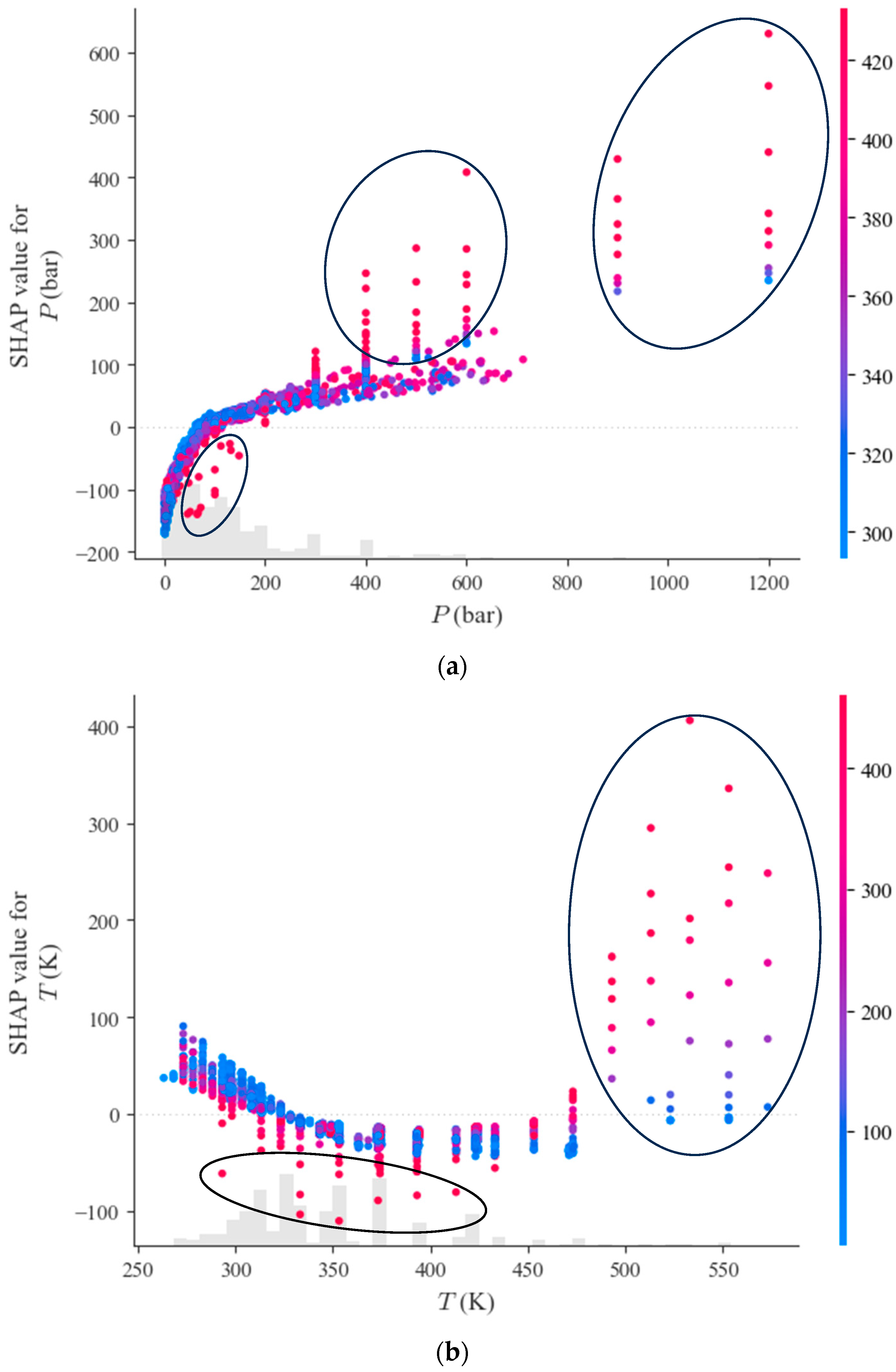

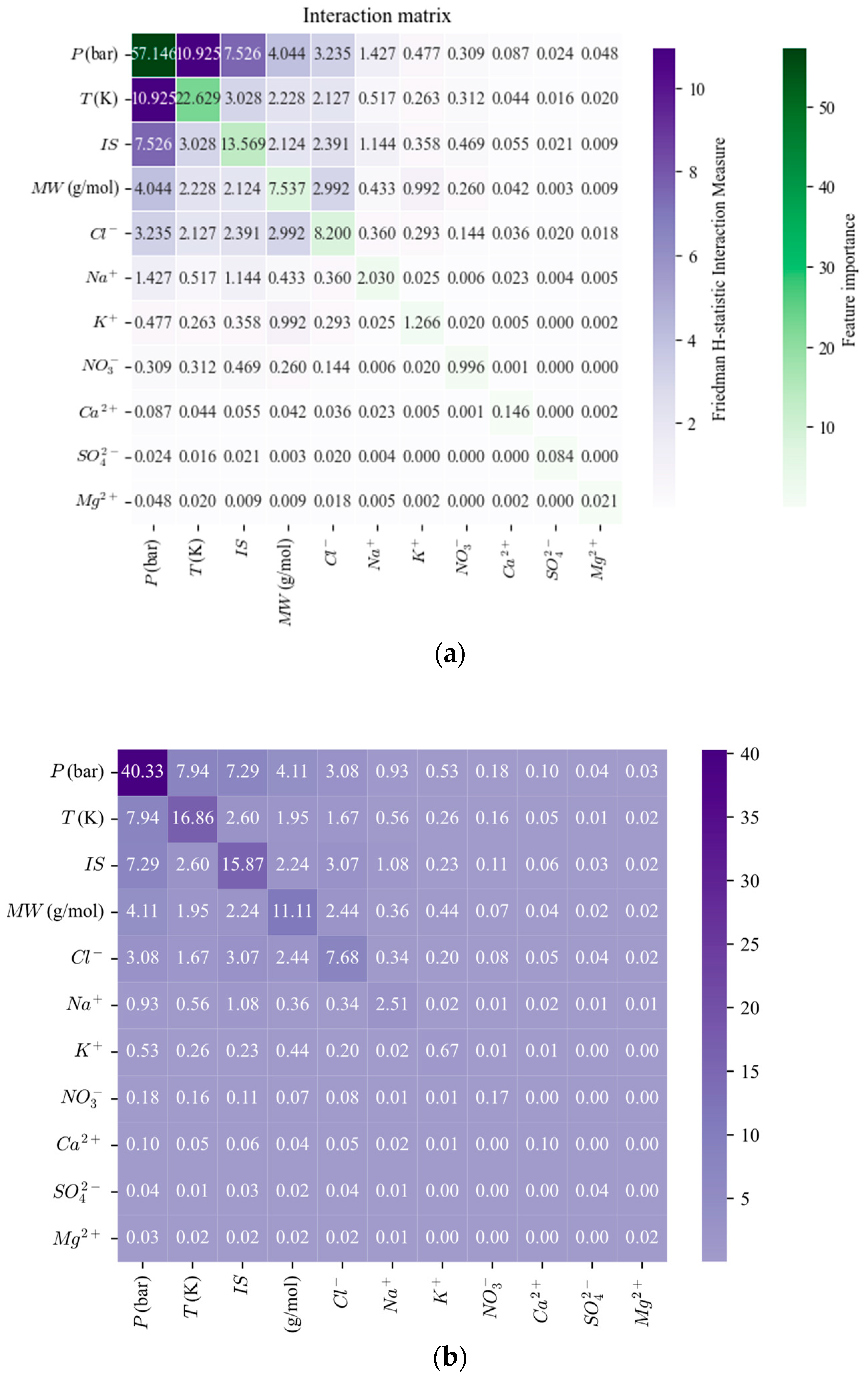
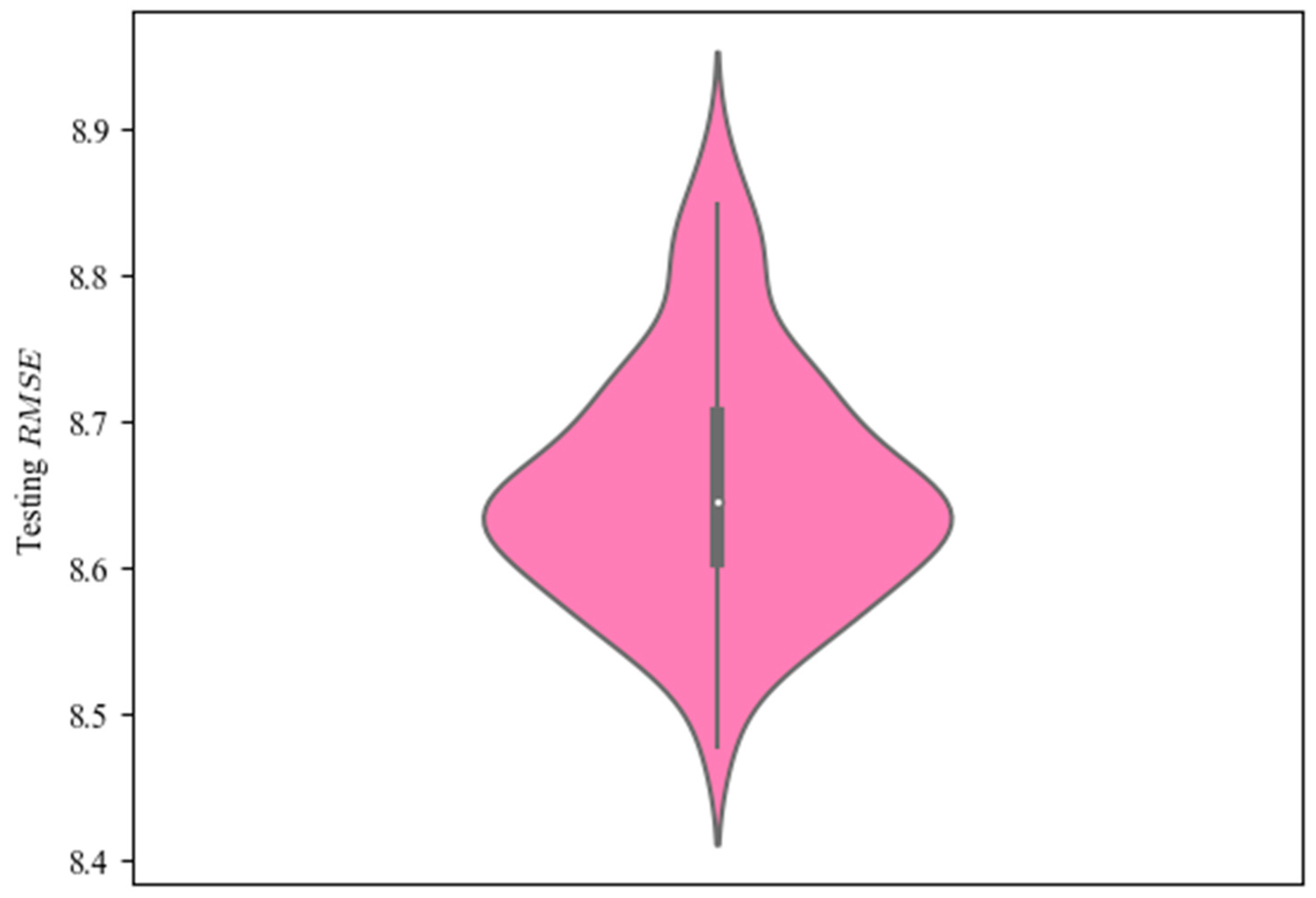
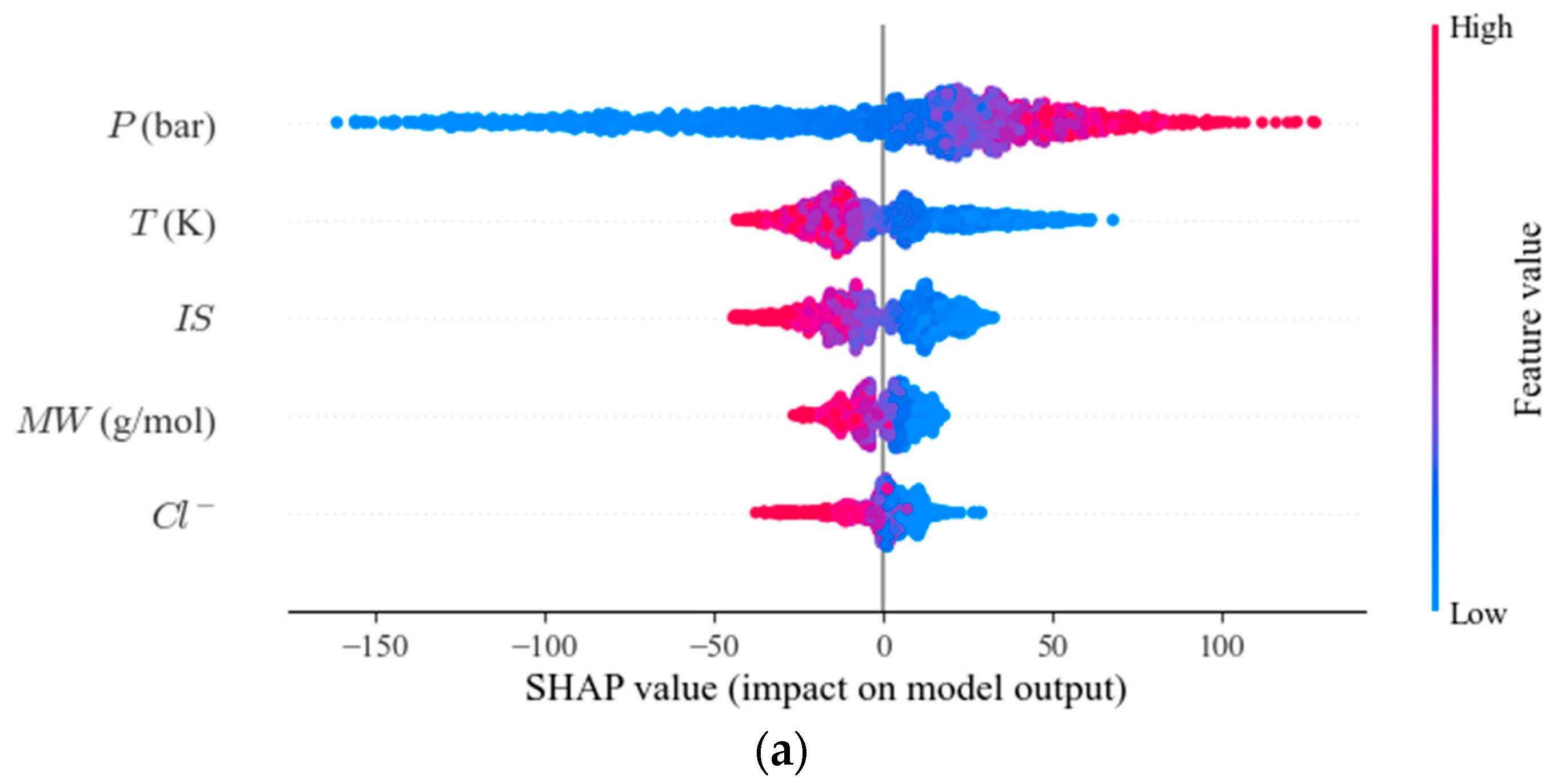
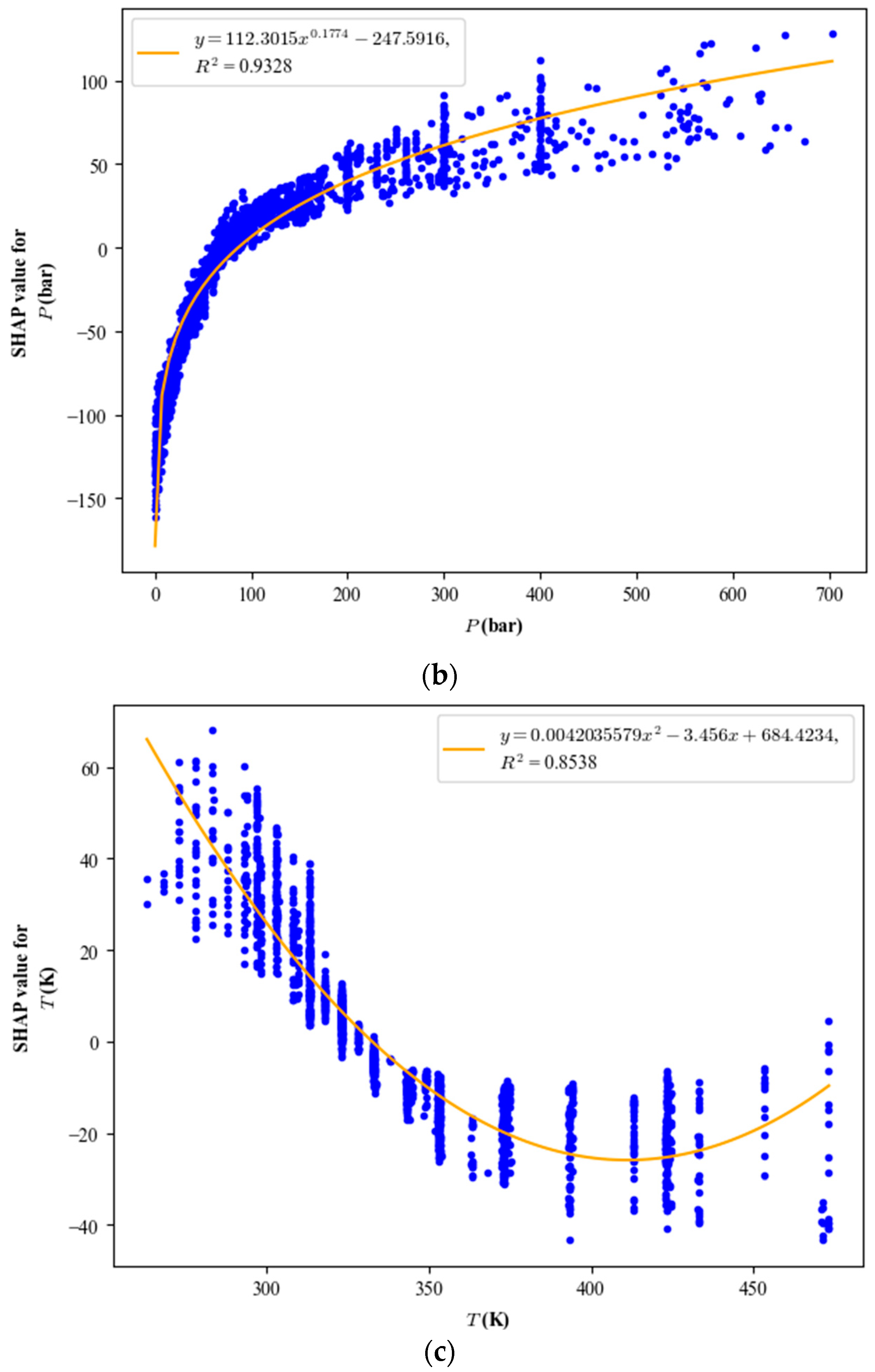
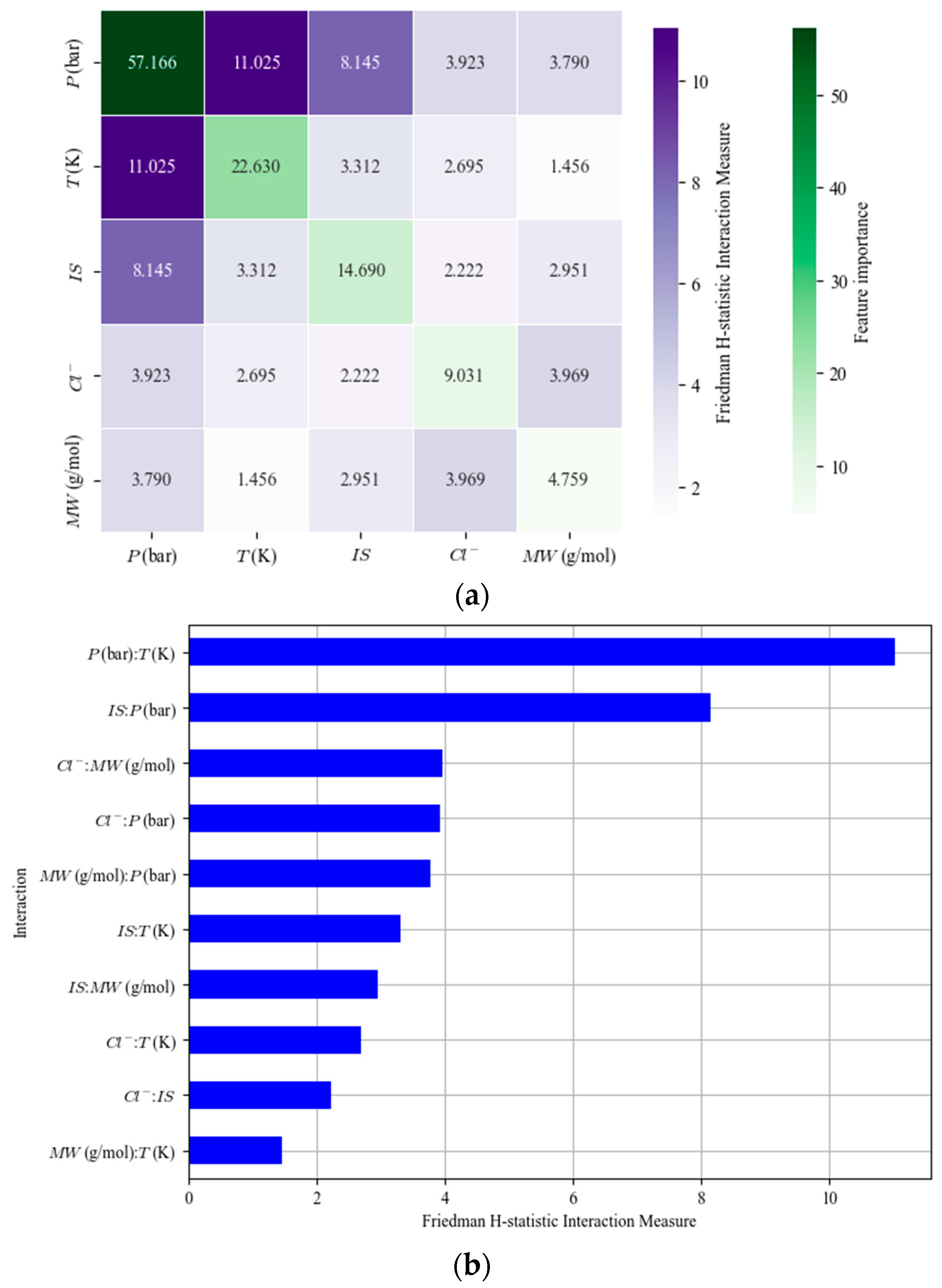
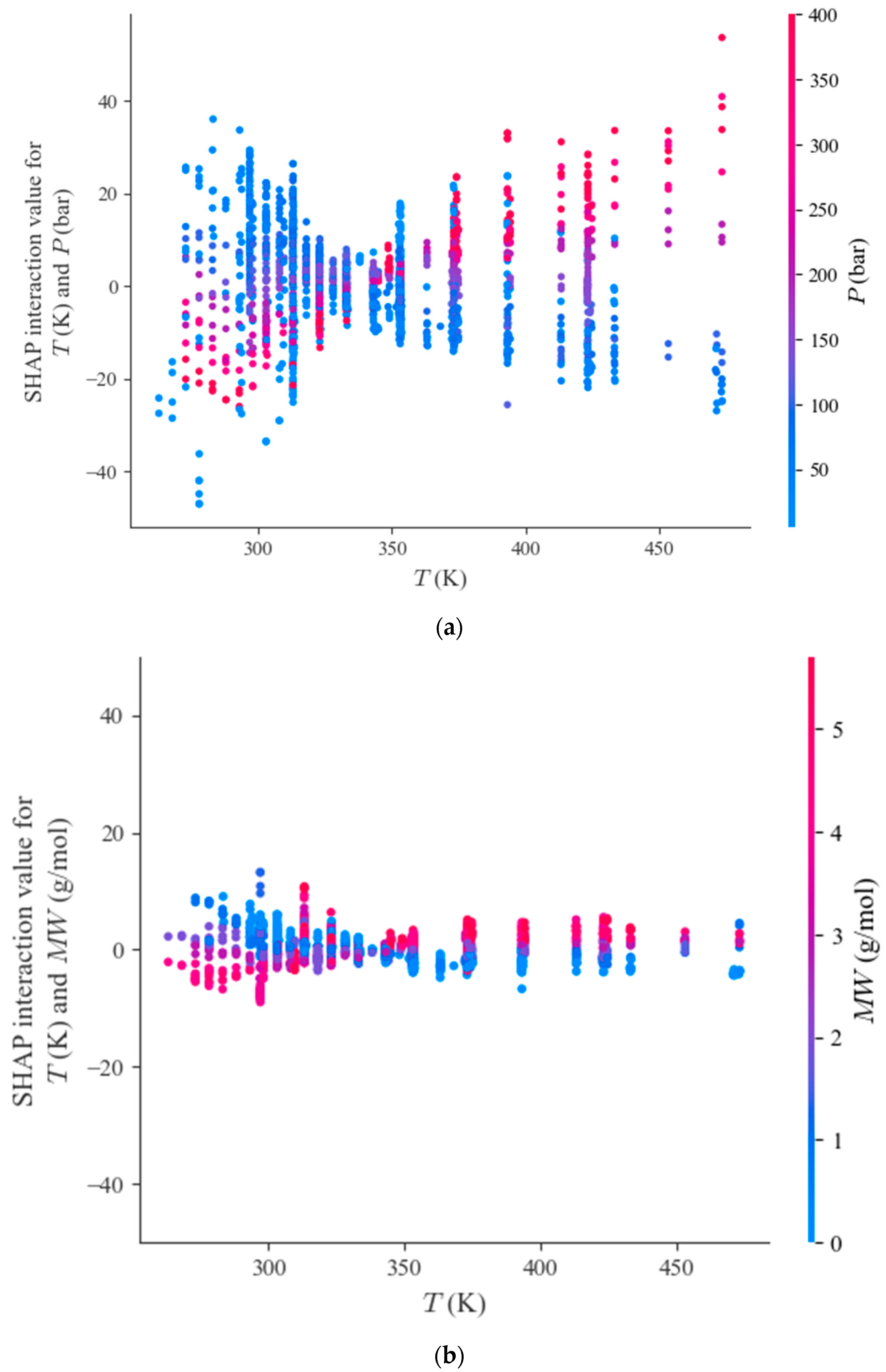
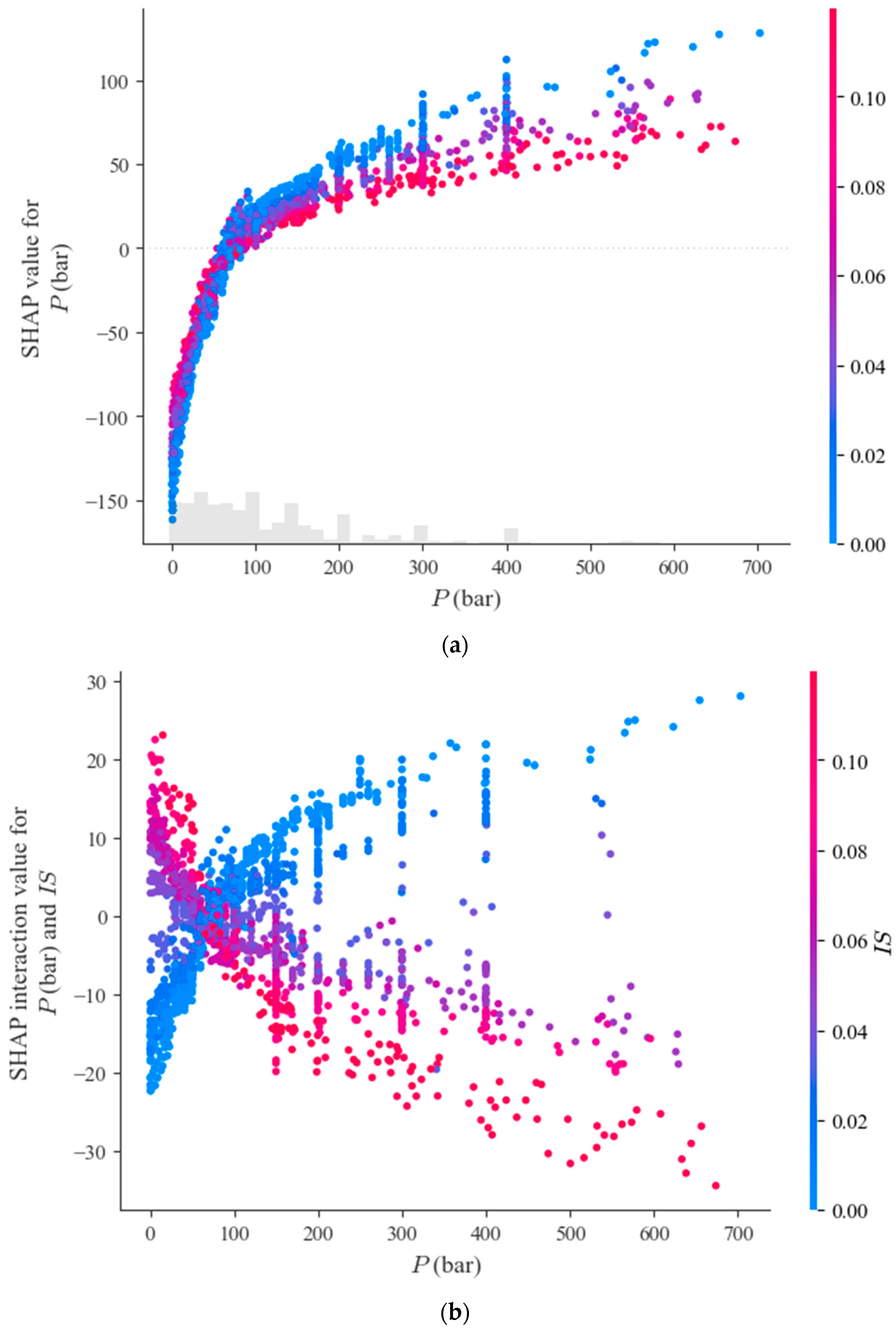
| Year | Author(s) | Solution | P (bar) | T (K) | Model(s) | NSamples |
|---|---|---|---|---|---|---|
| 2022 | Sun et al. [61] | Pure Water | 1–1000 | 288.15–423.15 | SVR | 316 |
| 2022 | Mohammadian et al. [62] | NaCl | 1.01–202.65 | 298.00–373.00 | XGB MLP KNN GA | 164 |
| 2021 | Jeon and Lee [63] | Pure Water NaCl CaCl2 MgCl2 MgSO4 KCl K2SO4 NaHCO3 Na2SO4 | 0.92–712.31 | 273.15–473.65 | ANN | 2406 |
| 2021 | Sayahi et al. [64] | N/A | 12.50–400 | 308.00–424.68 | RBFNN LSSVM | 129 |
| 2020 | Hemmati-Sarapardeh et al. [50] | Pure Water | 0.003–3500 | 197.60–623.15 | RBFNN MLP LSSVM | 785 |
| 2020 | Nabipour et al. [65] | Pure Water NaCl CaCl2 MgCl2 MgSO4 KCl NaHCO3 NaOH NaBr | 2.3–712.10 | 278–473.15 | ELM LSSVM | 634 |
| 2019 | Raji et al. [66] | N/A | 0.0651–885.58 | 286.97–433.16 | LSSVM ANN ANFIS | 608 |
| 2019 | Menad et al. [67] | N/A | 0.98–1400 | 273.15–723.15 | MLP RBFNN LM | 570 |
| 2016 | Ali Ahmadi and Ahmadi [68] | N/A | N/A | N/A | LSSVM | N/A |
| Salt | References | NStudies | Year | x_Salt (Mole Fraction) | P (Bar) | T (K) | x_CO2 |
|---|---|---|---|---|---|---|---|
| No Salt | |||||||
| Pure Water | [27,33,37,42,69,70,71,72,73,74,75,76,77,78,79,80,81,82,83,84,85,86] | 22 | 1945–2021 | 0 | 0.078–1200.0 | 273.15–573.15 | 0.0–0.149639 |
| Sinlge Salt | |||||||
| CaCl2 | [37,69,82,86,87,88,89,90] | 8 | 1945–2021 | 0.0–0.097546 | 9.5–712.3 | 308.00–424.64 | 0.000612–0.025457 |
| KCl | [33,37,80,82,88,91] | 6 | 2002–2016 | 0.008927–0.074988 | 0.07–548.3 | 297.00–423.15 | 0.0–0.0252 |
| KNO3 | [92] | 1 | 2003 | 0.017522–0.08248 | 0.07–102.1 | 313.16–373.15 | 0.0–0.024886 |
| MgCl2 | [80,82,87,88] | 4 | 2013–2016 | 0.005963–0.082632 | 12.5–544.8 | 297.00–424.68 | 0.001417–0.0218 |
| Na2SO4 | [88] | 1 | 2015 | 0.005963–0.034777 | 150.0 | 323.00–423.00 | 0.006959–0.0182 |
| NaCl | [28,33,37,42,70,71,72,73,74,77,78,79,80,81,82,83,84,85,86,91,93,94,95] | 23 | 1989–2021 | 0.00031–0.097546 | 0.067–572.5 | 263.15–553.15 | 0.0–0.030647 |
| NaNO3 | [92] | 1 | 2003 | 0.017696–0.153684 | 0.067–107.6 | 313.18–373.24 | 0.0–0.02147 |
| Dual Salts | |||||||
| CaCl2 + KCl | [37] | 1 | 2011 | 0.00882 + 0.01313 | 20.9–158.7 | 318.15 | 0.005612–0.01647 |
| CaCl2 + NaCl | [37,96] | 2 | 2011–2019 | 0.003514 + 0.016689– 0.008788 + 0.021086 | 10.1–199.3 | 318.15–423.0 | 0.000666–0.017802 |
| KCl + NaCl | [37,87] | 2 | 2011–2013 | 0.002528 + 0.016088– 0.013027 + 0.016617 | 10.7–171.6 | 308.90–424.67 | 0.003057–0.0161 |
| NaCl + CaCl2 | [86] | 1 | 2021 | 0.021086 + 0.003514 | 60.3–400.7 | 333.15–453.15 | 0.005375–0.024086 |
| NaCl + KCl | [97] | 1 | 2012 | 0.015151 + 0.002372 | 3.4–90.0 | 306.15–343.15 | 0.00081–0.017957 |
| Triple Salts | |||||||
| CaCl2 + KCl + NaCl | [37,96] | 2 | 2011–2019 | 0.002818 + 0.001754 + 0.005352– 0.008691 + 0.012938 + 0.021049 | 10.0–199.7 | 308.15–423.00 | 0.00067–0.020135 |
| Quartet Salts | |||||||
| NaCl + CaCl2+ MgCl2 + KCl | [82] | 1 | 2016 | 0.071588 + 0.004469+ 0.002492 + 0.000868 | 100.27–571.0 | 323.15–423.15 | 0.0082–0.0148 |
| Variable | mean | std | min | Q1 | median | Q3 | max |
|---|---|---|---|---|---|---|---|
| K+ | 5.06 × 10−3 | 1.54 × 10−2 | 0 | 0 | 0 | 0 | 8.25 × 10−2 |
| Na+ | 1.81 × 10−2 | 2.62 × 10−2 | 0 | 0 | 0 | 3.31 × 10−2 | 9.75 × 10−2 |
| Ca2+ | 4.01 × 10−3 | 1.35 × 10−2 | 0 | 0 | 0 | 0 | 9.75 × 10−2 |
| Mg2+ | 1.51 × 10−3 | 8.87 × 10−3 | 0 | 0 | 0 | 0 | 8.26 × 10−2 |
| Cl− | 3.22 × 10−2 | 3.59 × 10−2 | 0 | 0 | 1.86 × 10−2 | 5.13 × 10−2 | 1.95 × 10−1 |
| NO3− | 1.75 × 10−3 | 1.03 × 10−2 | 0 | 0 | 0 | 0 | 8.25 × 10−2 |
| SO42− | 1.18 × 10−4 | 1.63 × 10−3 | 0 | 0 | 0 | 0 | 3.48 × 10−2 |
| IS | 3.98 × 10−2 | 4.79 × 10−2 | 0 | 0 | 3.16 × 10−2 | 5.34 × 10−2 | 2.93 × 10−1 |
| MW (g/mol) | 2.07 | 2.12 | 0 | 0 | 1.75 | 3.05 | 10.83 |
| P (bar) | 148.16 | 157.24 | 0.06 | 48 | 100 | 200 | 1200 |
| T (K) | 348.74 | 49.32 | 263.15 | 313.31 | 333.15 | 373.15 | 573.15 |
| x_CO2 (×10−4) | 133.13 | 100.44 | 0 | 72.61 | 123.48 | 176.96 | 1496.39 |
| Model | Hyperparameters | NFeatures | Set | AARD | RMSE | R2 | NSamples |
|---|---|---|---|---|---|---|---|
| Model I | max_depth: 24 | 11 | Train | 2.60 | 6.35 | 0.996 | 2136 |
| max_features: 8 | Test | 5.11 | 20.22 | 0.968 | 534 | ||
| Extra | 18.61 | 14.40 | 0.930 | 119 | |||
| Model II | max_depth: 16 | 11 | Train | 2.63 | 3.07 | 0.998 | 2022 |
| max_features: 9 | Test | 4.40 | 8.16 | 0.985 | 506 | ||
| Extra | 18.31 | 13.86 | 0.935 | 119 | |||
| Model III | max_depth: 14 | 5 | Train | 2.67 | 3.32 | 0.997 | 2022 |
| max_features: 4 | Test | 4.41 | 8.64 | 0.983 | 506 | ||
| Extra | 17.62 | 10.40 | 0.963 | 119 | |||
| Model IV | max_depth: 14 | 5 | Train | 2.62 | 3.39 | 0.997 | 2022 |
| max_features: 4 | Test | 4.35 | 8.48 | 0.984 | 506 | ||
| Extra | 16.87 | 9.96 | 0.966 | 119 |
Disclaimer/Publisher’s Note: The statements, opinions and data contained in all publications are solely those of the individual author(s) and contributor(s) and not of MDPI and/or the editor(s). MDPI and/or the editor(s) disclaim responsibility for any injury to people or property resulting from any ideas, methods, instructions or products referred to in the content. |
© 2024 by the authors. Licensee MDPI, Basel, Switzerland. This article is an open access article distributed under the terms and conditions of the Creative Commons Attribution (CC BY) license (https://creativecommons.org/licenses/by/4.0/).
Share and Cite
Shokrollahi, A.; Tatar, A.; Zeinijahromi, A. Advancing CO2 Solubility Prediction in Brine Solutions with Explainable Artificial Intelligence for Sustainable Subsurface Storage. Sustainability 2024, 16, 7273. https://doi.org/10.3390/su16177273
Shokrollahi A, Tatar A, Zeinijahromi A. Advancing CO2 Solubility Prediction in Brine Solutions with Explainable Artificial Intelligence for Sustainable Subsurface Storage. Sustainability. 2024; 16(17):7273. https://doi.org/10.3390/su16177273
Chicago/Turabian StyleShokrollahi, Amin, Afshin Tatar, and Abbas Zeinijahromi. 2024. "Advancing CO2 Solubility Prediction in Brine Solutions with Explainable Artificial Intelligence for Sustainable Subsurface Storage" Sustainability 16, no. 17: 7273. https://doi.org/10.3390/su16177273
APA StyleShokrollahi, A., Tatar, A., & Zeinijahromi, A. (2024). Advancing CO2 Solubility Prediction in Brine Solutions with Explainable Artificial Intelligence for Sustainable Subsurface Storage. Sustainability, 16(17), 7273. https://doi.org/10.3390/su16177273






